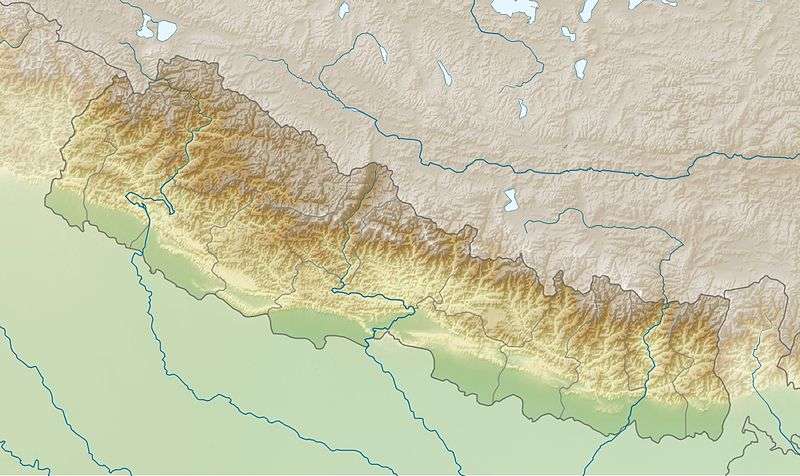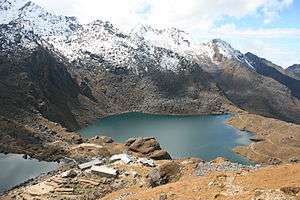Langtang National Park
| Langtang National Park | |
|---|---|
|
IUCN category II (national park) | |
|
Starry night in Langtang National Park | |
 | |
| Location | Nepal |
| Nearest city | Kathmandu |
| Coordinates | 28°10′26″N 85°33′11″E / 28.1738°N 85.5531°ECoordinates: 28°10′26″N 85°33′11″E / 28.1738°N 85.5531°E |
| Area | 1,710 km2 (660 sq mi) |
| Established | 1976 |
| Governing body | Department of National Parks and Wildlife Conservation, Ministry of Forests and Soil Conservation |


The Langtang National Park is the fourth national park in Nepal and was established in 1976 as the first Himalayan national park. The protected area exceeds an altitudinal range of 6,450 m (21,160 ft) and covers an area of 1,710 km2 (660 sq mi) in the Nuwakot, Rasuwa and Sindhulpalchok districts of the central Himalayan region encompassing 26 Village Development Committees. It is linked with the Qomolangma National Nature Preserve in Tibet. The high altitude sacred lake of Gosainkunda falls within the park.[1] The Gosainkunda lake (4,300 m (14,100 ft)) and the Dorje Lakpa range (6,988 m (22,927 ft)) bisect the park from east–west to south–east. The summit of Langtang Lirung (7,245 m (23,770 ft)) is the highest point in the park.[2]
The northern and eastern border of the national park coincide with the international border to Tibet. The western boundary follows the rivers Bhote Kosi and Trisuli. The southern border lies 32 km (20 mi) north of the Kathmandu Valley.[3]
This protected area represents both Indo-Malayan and Palearctic ecozones.[4]
History
In 1970, royal approval designated the establishment of Langtang National Park as the first protected area in the Himalayas. The national park was gazetted in 1976 and extended by a buffer zone of 420 km2 (160 sq mi) in 1998.[1] Under the Buffer Zone Management Guidelines the conservation of forests, wildlife and cultural resources received top priority, followed by conservation of other natural resources and development of alternative energy.[5]
Climate
The climate of the park is dominated by the southwest summer monsoon. Temperatures vary greatly due to the extreme difference in altitude in the entire area. Most of the annual precipitation occurs from June to September. From October to November and from April to May, days are warm and sunny, and nights cool. In spring, rain at 3,000 m (9,800 ft) elevation often turns to snow at higher elevations. In winter from December to March, days are clear and mild but nights near freezing.[6]
Vegetation
The Langtang National Park exhibits a high diversity of 14 vegetation types in 18 ecosystem types, ranging from upper tropical forests below 1,000 m (3,300 ft) m altitude to alpine scrub and perennial ice.[1]
References
- 1 2 3 Bhuju, U. R., Shakya, P. R., Basnet, T. B., Shrestha, S. (2007). Nepal Biodiversity Resource Book. Protected Areas, Ramsar Sites, and World Heritage Sites. International Centre for Integrated Mountain Development, Ministry of Environment, Science and Technology, in cooperation with United Nations Environment Programme, Regional Office for Asia and the Pacific. Kathmandu, ISBN 978-92-9115-033-5
- ↑ Mishra, P. N. (2003). The Langtang National Park: a proposed first Biosphere Reserve in Nepal. Journal of the National Science Foundation of Sri Lanka 31 (1&2): 333–335.
- ↑ Yonzon, P., Jones, R., Fox, J. (1991). Geographic Information Systems for Assessing Habitat and Estimating Population of Red Pandas in Langtang National Park, Nepal. Ambio 20 (7) (Nov 1991): 285–288.
- ↑ DNPWC (2012). "Sacred Himalayan Landscape". Department of National Parks and Wildlife Conservation, Government of Nepal, Kathmandu.
- ↑ Heinen, J. T. and J. N. Mehta (2000). Emerging Issues in Legal and Procedural Aspects of Buffer Zone Management with Case Studies from Nepal. Journal of Environment and Development 9 (1): 45–67.
- ↑ Sayers, K., Norconk, M.A. (2008). Himalayan Semnopithecus entellus at Langtang National Park, Nepal: Diet, Activity Patterns, and Resources. International Journal of Primatology (2008) 29: 509–530.
External links
- Department of National Parks and Wildlife Conservation: Langtang National Park
- BirdLife International Important Bird Areas factsheet: Langtang National Park
- Nepal Tourism directory: Langtang National Park
- Description of Langtang National Park trekking route
- EnvironmentNEPAL Langtang National Park
